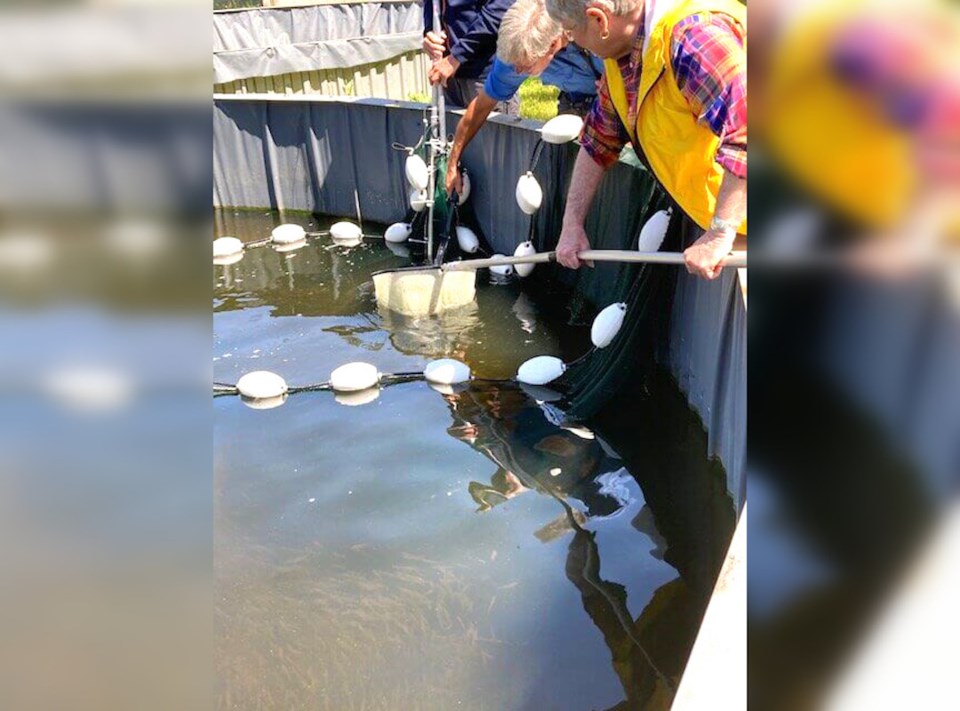Two days before the water flowing down Chapman Creek reserved for environmental purposes was reduced by 20 per cent, a third well came online at the Chapman Creek Hatchery.
It happened “in a big panic because I knew they were dropping the flow,” hatchery manager Bill Krause told Coast Reporter.
However, Krause said he has yet to see the reduction dramatically affect creek flows, with water levels dropping by about one centimetre as of Oct. 23.
The new well is another example of how the hatchery has been forced to make dramatic changes to its operations because of increasingly frequent droughts hitting the Sunshine Coast.
Less water coming into the creek
On Oct. 18, Sunshine Coast Regional District (SCRD) said it had received federal and provincial permission to reduce environmental flow needs (EFN) levels for Chapman Creek by 20 per cent to 160 litres per second from 200 litres. The flow reduction took effect two days later.
Provincial policy governs EFN, which is defined by how much flow is needed in a stream to ensure aquatic ecosystems function properly.
The 35-year-old hatchery, one kilometre from Davis Bay, has a water licence permitting it to siphon water from Chapman Creek using an intake pipe, which supplies water for tanks and its incubation building.
During “low flow conditions” the hatchery can’t legally remove water from Chapman Creek, according to a 2019 Sunshine Coast Salmonid Enhancement Society report, because doing so would reduce EFN levels in the 200 metres between the intake and outflow areas of the hatchery.
The hatchery was not involved in the recent decision to reduce flows and Krause told Coast Reporter he has not been instructed to reduce its use of creek water.
“We’re using as little water as we possibly can to keep the fish happy,” he said.
The hatchery depends on water this time of year for holding ponds, where returning adults spawn, and for incubation.
The hatchery is also holding approximately 39,000 coho juveniles in its tanks.
Approximately 400 litres per minute of water flows through those tanks and out to a settling pond before re-entering the creek. The used water acts as an attractant and entices adults to return during spawning season.
Well, well, well
Three on-site wells were tested at the hatchery in 2021 and one was deemed viable, but the hatchery had been waiting on a pump and motor for the past six months before the well could be brought online.
Two other wells supplement water from Chapman Creek at the hatchery – one activated in February 2022 and another, used for incubation, in 2015.
In 2020, before additional wells went online, former hatchery manager Simon Grant told Sechelt Council the Department of Fisheries and Oceans instructed the society to reduce production targets to less than 10,000 from 50,000 for coho, “if the water situation for coho is not resolved.”
At the time he said the reduction would have a significant impact on the local economy and sport fishing.
Stephen Boale, president of the Salmonid Enhancement Society Board, which runs the hatchery, said the hatchery’s work couldn’t continue without access to a backup water source.
Well water has allowed hatchery to maintain targets
Issues with low flow and warm water temperatures forced the hatchery to send its coho salmon to North Vancouver’s Capilano Hatchery in 2019.
And in 2021, most of the hatchery’s coho salmon were transported to tanks at Port Mellon because of water issues.
This year, the additional well water has allowed the fish to remain at the hatchery year-round, said Krause. For a short period, the hatchery used well water exclusively.
The additional well water has allowed the hatchery to maintain its release targets: 50,000 for coho, 250,000 for pinks, 70,000 for chinook and approximately 90,000 for chum.
Using well water is more expensive, said Krause, because it requires energy to pump and aerate, however the well water ensures fish have cooler, clean water all year.
Impact of EFN on water supply
In 2016, the province changed its EFN requirement for Chapman Creek, requiring 200 litres per second, which the SCRD said in a 2018 report, “represents a significant impact on the Chapman Lake water supply” – a reduction of about three weeks of drinking water supply. Prior to that, the target EFN for the creek was 120 litres per second.
But for salmon health, Krause told Coast Reporter, “anything less than [200 litres per second] is detrimental.”
I’d love to see more water… but there’s nothing much we can do about that. It’s the drinking water supply first and foremost.”
Salmon waiting for the weather to change
The EFN reduction will stay in place “until such time that Stage 4 is rescinded or until salmon are confirmed to be migrating upstream,” according to an Oct. 21 SCRD water emergency update. The Chapman watershed needs about 150 millimetres of rain before water regulations can change.
Environment Canada predicted up to 70 mm to fall in Sechelt by Oct. 28.
The salmon, which fishers and the general public have observed in Davis Bay, are also waiting for the changing weather pattern.
“I believe we’ve just barely dodged what could have been a huge disaster. If this drought continued on another three weeks or more, then we would be really seeing some major effects, because the salmon… could end up dying… or coming back with very little salmon habitat,” said Krause.
He said smaller streams will likely be adversely affected, since less water means reduced spawning habitat.
Water needed, but not too much
Too much water has also had a detrimental impact on the hatchery.
Earlier this year the society received $27,000 from the Sunshine Coast Community Forest Legacy Fund to fix the hatchery’s water intake structure, which was damaged last November during an intense period of flooding.
– With files from Keili Bartlett and Sean Eckford



